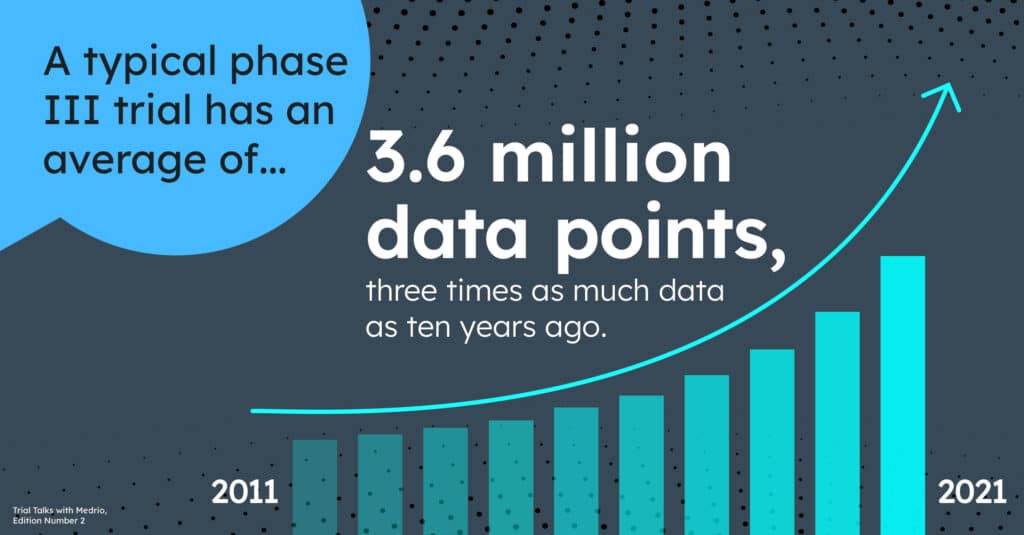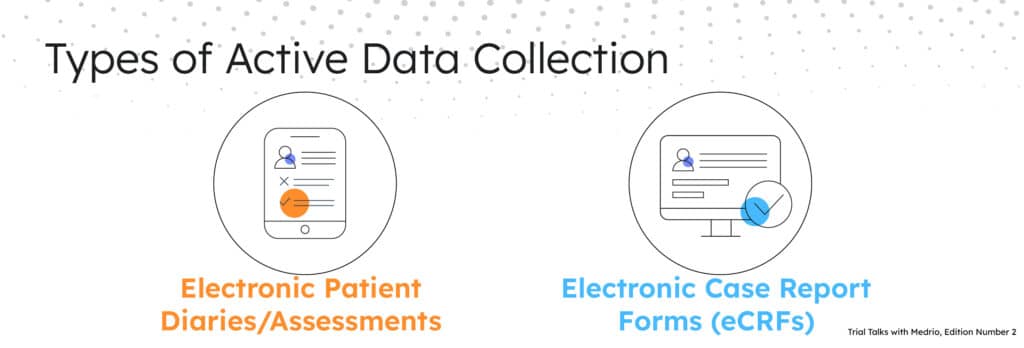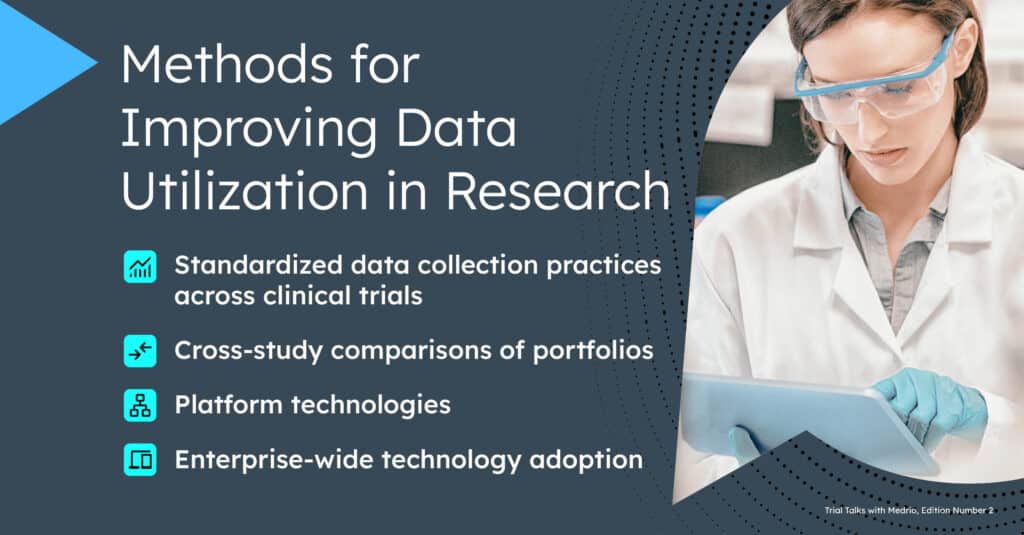Over the past five years, technology adoption has been at an all-time high in clinical trials. More technology coupled with more complex study designs means even greater volumes of data are pouring into the life sciences industry and data management in clinical research is at an inflection point.
This data could help us to serve patients better, accelerate trials, and more quickly develop effective treatments.
But, right now, this data is overwhelming researchers and study teams, which is why Paul Upham, Head of Smart Devices at Roche / Genentech; Rachel Chasse, Digital Operations Lead at ABBVIE; and Nicole Latimer, CEO of Medrio got together to discuss:
- How technology and data are currently influencing trials
- Where all the data is coming from
- Why clinical technology can improve data quality
- What are better strategies for data management in clinical research
You can watch the entire conversation from the original webinar with Paul, Rachel, and Nicole and gain additional insights about how technology affects patients.
The Current State of Clinical Trials
Technology can play a massive role in the future of clinical trials. But first, we must understand how to use it better and manage the data it produces.
Although the clinical research industry has adopted more tech than ever, study timelines are increasing, according to the Tufts Center for the Study of Drug Development.
Plus, sponsors, CROs, and research sites can be overwhelmed with the amount of data they need to collect, clean, and analyze during a clinical trial.
Why is technology affecting clinical trials in this way?
- More data is being collected.
- Trails are becoming more complex.
- Lack of change management assistance.
Trials have more data today than ever before. For example, a typical phase III trial has an average of 3.6 million data points, three times as much data as ten years ago.

Not only is there more data, but studies are more complex. Sponsors also register more multiphase or adaptive studies that plan for mid-study changes.
Not to mention, the pandemic fueled hasty technology adoption to keep trials running. Many eClinical tools were implemented with little to no change management assistance, resulting in less effective technology usage.
Increased data points and study complexity combined with the rush of technology adoption during the pandemic created the perfect storm for what we see today in the clinical research industry.
So, how can we use eClinical tools effectively to create faster, higher-quality clinical trials? Let’s look at the data.
Where Is All The Data Coming From?
Much of this data comes from the patient’s environment since electronic capture facilitates easier collection. The large amounts of data are also partly due to the explosion of consumer technology and the reduced cost of these measurement tools.
Information from labs, EHRs/EMRs, devices, sensors, and other data from third-party sources is also becoming more common in trials. This data creates efficiencies and facilitates real-time decision-making within a trial while giving a more well-rounded picture of what is happening with patients.
As Nicole mentioned, “Technology is actually allowing us to focus more so on the patient – the people who were all trying to help.”
Researchers are also driven to capture more patient data to develop personalized therapies. Immense knowledge and data are necessary to target these therapies precisely and understand how they will work in diverse sub-segments of patients.
So, both the availability of technology and the need for data are driving data growth. Most of this data is captured electronically at the source, either directly from patients or from third-parties. But we need the right eClinical tools and the right strategies to truly realize the potential of this data.
How Can Clinical Technology Improve Data Quality?
The primary clinical technology used in clinical trials involves either passive or active data collection. Both of these forms of data collection improve data quality. How? They allow for timeliness.
Patient data historically wasn’t incorporated into decision-making until the end of the trial. Now that data is being collected electronically in real-time, sponsors and others have direct visibility into patients, so modifications can happen quickly, ultimately improving both the data quality and the patient experience.
In addition to timeliness, there are accrued benefits of saved time and improved experiences for the patient and the trial site. Plus, passive data collection and active data collection provide unique data quality benefits.
Passive data collection
Passive or automatic data collection improves data quality by removing the potential errors associated with manual entry.
For example, patients manually entering information into diaries or assessments may misenter data or recall information to enter data later, potentially affecting the data quality. With passive collection, these potential data issues are removed.
Paul emphasized, “The more we move to automated, passive data collection, the more accurate the data will be as long as we are efficiently and effectively managing it.”

Active data collection
Active digital data collection may not eliminate as many initial manual entry errors. Still, it can provide data checks during entry, eliminating transcription errors from moving paper data to an electronic system.
Less potential for errors means higher-quality data, in addition to other benefits. And to get the highest-quality data from this method, sponsors and tech vendors should work with health literacy experts to ensure their eClinical tool is understandable to all patients.
“Putting forth a product that is understandable by many groups of people increases your data quality. You don’t want to ask someone something and they misinterpret it because you didn’t do your due diligence,” explains Rachel.

What are Better Strategies for Data Management in Clinical Research?
Sponsors and CROs need specific strategies to effectively use the large amounts of data flowing into clinical trials.
So, what methods create better data utilization in clinical trials?
- Standardized data collection practices across clinical trials
- Cross-study comparisons of portfolios
- Platform technologies
- Enterprise-wide technology adoption

Standardized data collection practices
“When we see the most successful sponsors and CROs implementing a standardized approach, that’s when they’re able to gain the efficiencies that you would expect from technology,” said Nicole.
With the right technology, sponsors and CROs can capture quality data in a controlled way. By using common frameworks across studies, sponsors enable analytics tools to be easily built while also facilitating the streamlined preparation of regulation approval materials.
Converting data into a standardized electronic format that can be identified, mapped and reused allows for sponsors and CROs to more efficiently analyze data coming from disparate sources.
Cross-study comparisons
Standardized data collection also allows for robust analytics tools, creating the ability for large cross-study databases or data lakes.
These robust data lakes can help sponsors cross-evaluate the entirety of their portfolio, generating evidence and efficacy not just for an individual study but across multiple trials.
Platform Technologies
Another strategy to help better manage data is developing platform technologies.
As Paul puts it, “Platform technologies, whether from a third party or we are developing them ourselves, have been critical to help and try to realize efficiencies.”
Instead of creating a new clinical data ecosystem for each trial, researchers can save time and generate efficiencies by deploying platform technology across a host of molecules for a particular disease or therapeutic area.
Enterprise-wide technology adoption
Lastly, enterprise-wide adoption of technology is critical for realizing the benefits of digital tools in clinical trials. Without this, data gathered from clinical technology is not as valuable.
Rachel commented, “Technology is the future, right? So if we continue to say we’re using technology in this study, but not these host of studies, or only these types of studies – then you’re going to get stuck.”
Enterprise-wide adoption starts with re-examining tech needs, reviewing existing tech, identifying any gaps, and, most importantly, educating staff. To future-proof and scale, education is key.
Rachel highlighted, “Future-proofing is also being fit for purpose – it is not adding more processes and things [technology] for the sake of it. It is taking a step back – how can we optimize this process to allow us to be competitive – and some of that comes from education.”
Harness Clinical Trial Data for Good
The data collected electronically in clinical trials has the potential to improve research. Not only getting treatments to people in need faster but also improving the experience for patients, researchers, and study teams.
We can only reach this research potential by effectively using technology and managing data.
Moving Beyond Tech Adoption: The Future of Clinical Trial Technology
We only covered part of Paul, Rachel, and Nicole’s conversation in this article. Watch the entire conversation and gain additional insights about how technology affects patients.
